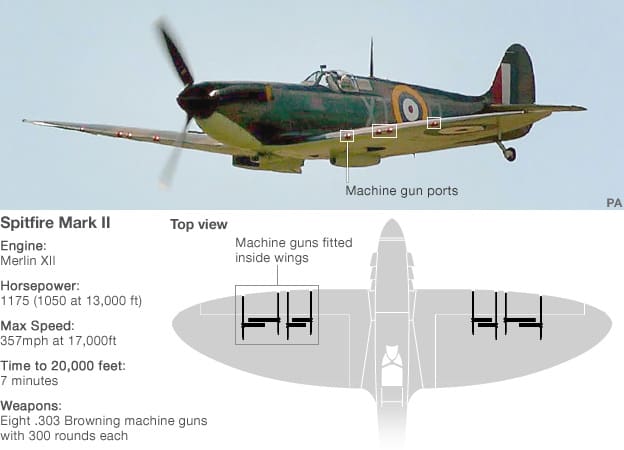As you surely know, today is Veterans Day. So take a vet you know to lunch. Better yet, buy one a beer and thank him or her for their service. And when you’ve properly done that, hoist another to the man who kept so many of them alive and gave them a lot of the tools they needed to keep us all free. That’s right, John Moses Browning. And if you needed any more reason to marvel at his genius, consider the condition of six Browning .303 caliber machine guns that crashed into an Irish bog – along with the Spitfire fighter that was carrying them – seventy years ago this month…
An American pilot, Roland “Bud” Wolf, experienced engine trouble after a sortie over the Atlantic and bailed out over Donegal in November of 1941. His Spitfire – the workhorse that fought off Messerschmitts and Heinkel bombers – crashed into a peat bog where it’s remained for seven decades.
The machine guns were recently dug out of the muck by an Irish army unit. Six of the eight guns in the Spitfire’s compliment, along with hundreds or rounds of ammo, were still in remarkably good shape, apparently largely rust free. The Beeb documented the effort:
Thanks to a “wild idea” from Lt Colonel Dave Sexton, ordnance technical officer in the Irish army, it was decided an attempt would be made to fire one of the Browning guns that had spent 70 years in the bog.
His team painstakingly cleaned the weapons and straightened pieces bent by the impact. Finally, on Tuesday we were able to stand on an old British Army range just north of Athlone for the big day.
The machine guns looked as good as new. Soil conditions were perfect for preservation. Beneath the peat there had been a layer of clay. Clay is anaerobic, it forms an airtight seal around all the parts, so there is no oxygen, which limits corrosion.
Had they been in sandy soil, which lets in water and air, the metal would have been heavily corroded.
The Irish specialists had chosen the best preserved body and added parts from all six guns, like the breech block and the spring, to assemble one that they thought would fire. They made the decision to use modern bullets, to reduce the risk of jamming.
I turned the handle of the remote firing mechanism. The Browning roared, the belt of ammunition disappeared, the spent shell cases were spat out and the muzzle flash stood out sharply against a grey sky. It was elating.
That was the noise that filled the air during the Battle of Britain.
Click the link, above, to hear the gun roar.
To be fair, the Brit factory workers who built the guns to such high tolerances while dodging Nazi bombs deserve a fair amount of the credit, too. But, as with so many of his creations that have stood the test of time, JMB’s designs continue to be marvels of firearm design.
[h/t Tyler Kee]





A great gun article for Armistice Day (Remembrance Day in the Commonwealth) but the airplane that won the Battle of Britain was the Hawker Hurricane and not the Spitfire. Two thirds of the squadrons of RAF Fighter Command during the crucial weeks of the battle were equipped with Hurricane.
+1 Supermarine Spitfire gets all the credit with its cool name and sexy wing, but Hurricane did most of the work.
The American pilot, Roland ‘Bud’ Wolfe lost his citizenship. Guess nobody was all angry as after being detained in a Irish POW camp he went on to join the Army Air Corp. Eventually served in Korea and Viet Nam.
Maybe Mother Nature should get most credit. Different conditions and neither genius nor craftsmanship would make any difference.
http://www.bbc.co.uk/news/magazine-13924720
It is an extremely interesting story about his POW experience.
I prefer the P-51 myself. Almost all allied aircraft in WWII toted M2’s though.
What about that P38 that was buried under ice?
What about that P38 that was buried under ice?Yeah, buried under 300 feet of accumulated ice since they landed there in WWII. A testament to global warming. (sarc)
clearly, JMB’s wisdom knows no bounds.
Great post! you should read some of the birth comments on the bbc link. Crying about how this gun should not be used for “fun.” Uhg gimme a break.
@ tdiinva
you know your history man, well done.
.303!? Jeebus – plinker rounds. No wonder it took six of them.
As awesome as browning was I think it was more dumb luck that preserved the guns
Comments are closed.